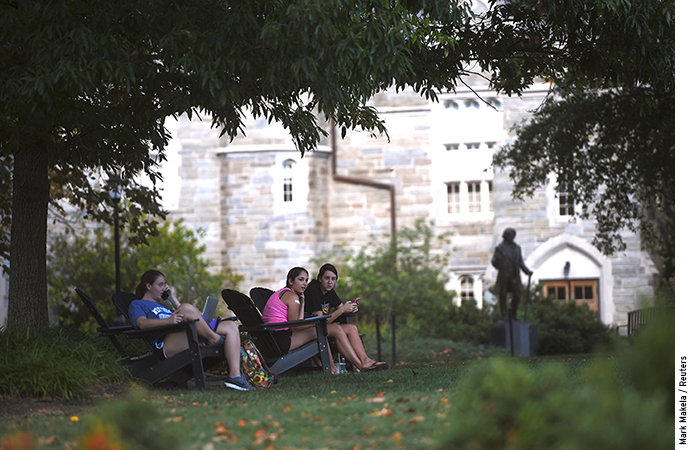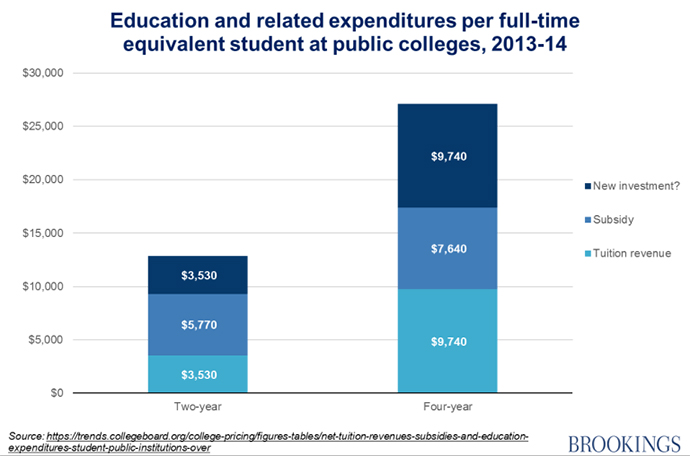
Making public higher education tuition-free has gone from a fringe idea to the platform of the Democratic Party in a short period of time. President Obama proposed making community college free in early 2015. Hillary Clinton has augmented that proposal to include four-year colleges for families making up to $125,000.[i] Many Democrats will push for federal action to make college free when the new Congress convenes in 2017, and they will have a powerful supporter in Clinton if she wins the presidency.
The Clinton campaign estimates that her higher education plan will increase federal spending on higher education by an average of $50 billion per year, or about $4,700 per undergraduate student.[ii] The question facing policymakers and the public is not whether eliminating tuition at public colleges for most families will have a positive effect, but whether it is the best use of a large new federal investment in higher education.
An often-discussed alternative to free college is providing even more generous benefits but to a more carefully targeted group of students with financial need. In a previous contribution to this series, I estimated the large subsidies that Senator Bernie Sanders’s free college policy would direct to relatively affluent families. Clinton’s plan would provide fewer benefits to high-income families, but would still eliminate tuition for more than three-quarters of families.[iii] A more targeted plan could instead eliminate tuition for low- and middle-income students, and do more to cover the living costs of the neediest students.[iv]
A less-discussed alternative to free college is to invest directly in colleges, especially those that serve low-income students, with the goal of increasing quality rather than only reducing price. Spending at many historically under-resourced institutions has been largely flat in recent years, despite increases in tuition driven by declining state support. For example, per-student expenditures at community colleges increased by less than $400, from $8,910 to $9,300, between 2003-04 and 2013-14.[v]
Community colleges spend 46 percent less per student than four-year colleges: $9,300 vs. $17,380.[vi] And community colleges have notoriously low completion rates, with their students much less likely than their counterparts at public four-year colleges to earn a degree from their original institution (26 vs. 48 percent) or from any institution (38 vs. 61 percent).[vii] But since four-year colleges charge more in tuition, their students would benefit more from a free college plan than community college students.
New federal spending to eliminate tuition would be substantial relative to current expenditures at public colleges. Spending at public colleges and universities is shown in the figure below as the sum of tuition revenue (net of institutional grants) and subsidies (mostly from the state). The dashed boxes show the hypothetical increase in spending that would have roughly the same cost as eliminating tuition.[viii] The increases would be very large—equivalent to 38 percent of current spending at community colleges and 56 percent at four-year public colleges.

The impact of increased spending by institutions on student outcomes would obviously depend on how the new money is spent, but there is strong evidence that a combination of grants and other supports can dramatically improve the outcomes of disadvantaged students. Lindsay Page and Stacy Kehoe from the University of Pittsburgh review studies of a number of such programs, such as the Dell Scholars program, which increased bachelor’s degree attainment from 61 to 75 percent, and the City University of New York’s Accelerated Study in Associates Program (ASAP), which increased associates degree attainment from 18 to 33 percent.[ix]
These kinds of comprehensive support programs are expensive. The ASAP program cost $16,284 per student over three years ($5,428 per year), and the Dell Scholarships program had a price tag of $30,000 ($5,000 per year if divided over the six years for which students were tracked).[x] But their substantial cost may be justified by the large impacts they have on degree attainment: 14-15 percentage points.
Studies of primarily financial supports for low-income students find smaller impacts, but for less costly programs.[xi] Page and Kehoe also summarize two studies of financial assistance to low-income students: one from Florida, where a $1,300 annual grant increased six-year bachelor’s degree attainment from 21 to 26 percent, and another from Wisconsin, where a $3,500 annual award increased on-time graduation rates from 16 to 21 percent.
There is less research on the impact of reducing tuition for higher-income students, who already have higher rates of college completion. Economic theory suggests that further subsidizing these students would have a smaller effect, given that these students, on average, can draw on family support to pay for college. In addition, there is evidence that relatively small subsidies can push students to attend lower-quality institutions, reducing their success rates.[xii] As a result, a policy that reduced or eliminated tuition for all students would likely have an average effect smaller than the impacts on low-income students described above.[xiii]
Both types of policies—reducing tuition and increasing spending on institutions—would present design challenges for federal policymakers. Federal free college plans require either bailing out the states that spend the least on their public colleges or creating a system of incentives for states that will likely result in less than universal participation. It would be much more straightforward to provide new targeted aid through an expanded version of the Pell grant program, which could also be made more simple, transparent, and easy to access (e.g., by eliminating the FAFSA and using income tax records to determine eligibility).
There is much less precedent for direct federal support of institutions.[xiv] Funding institutions directly would have the potential advantage of bypassing hesitant states, but would likely require regulations aimed at focusing new spending on evidence-based programs. This strategy would obviously not address the problem of declining state support, and significant new federal support could in fact make it easier for states to reduce their spending. A more modest possible starting point would be a grant competition to fund institution-based programs with a track record of increasing student success.
* * *
Free college does little for historically under-resourced institutions, which enroll many disadvantaged students but too rarely serve them well. Providing the right mix of financial aid and non-financial supports to the students who need them most is far more likely to improve this state of affairs than eliminating tuition for all or most families. Free college may make for a nice stump speech, but once campaigning gives way to governing, policymakers should select the combination of policies most likely to improve students’ chances of success in college and in life.
— Matthew M. Chingos
Matthew M. Chingos is a Senior Fellow at the Urban Institute.
This post originally appeared as part of Evidence Speaks, a weekly series of reports and notes by a standing panel of researchers under the editorship of Russ Whitehurst.
Notes:
[i] https://www.hillaryclinton.com/issues/college/.
[ii] http://www.wsj.com/articles/hillary-clintons-free-college-tuition-plan-coming-up-short-on-specifics-1471167001. Calculated based on 2014-15 full-time equivalent enrollment in degree-granting public institutions in NCES Digest of Education Statistics Table 307.10 (https://nces.ed.gov/programs/digest/d15/tables/dt15_307.10.asp?current=yes). The price tag for the Clinton plan includes not just new tuition subsidies, but also changes to the student loan program and other proposals.
[iii] 2011 IPUMS microdata show that 79 percent of children aged 14-17 are from families with less than $125,000 in household income (in 2016 dollars).
[iv] The Clinton plan aims to eliminate tuition for all students but retains Pell grants to help low-income students cover living costs. A more targeted plan could provide additional support to low-income students, or extend Pell further up the income distribution.
[v] https://trends.collegeboard.org/college-pricing/figures-tables/net-tuition-revenues-subsidies-and-education-expenditures-student-public-institutions-over. All expenditures discussed in this note are education and related expenditures and comparisons over time are adjusted for inflation.
[vi] https://trends.collegeboard.org/college-pricing/figures-tables/net-tuition-revenues-subsidies-and-education-expenditures-student-public-institutions-over.
[vii] See Figure 12 of https://nscresearchcenter.org/wp-content/uploads/SignatureReport10.pdf. There is a significant body of high-quality evidence showing that part of this difference is causal (not explained by differences in student characteristics between two- and four-year colleges), although community colleges likely increase educational attainment relative to not attending college at all (http://papers.ccpr.ucla.edu/papers/PWP-CCPR-2012-004/PWP-CCPR-2012-004.pdf).
[viii] This assumes that the cost of eliminating tuition is roughly equivalent to net tuition revenue. That should be the case for a plan that eliminated tuition and redirected Pell grants to students to help cover living costs (as Bernie Sanders proposed, and as Hillary Clinton has proposed for families making less than $125,000).
[ix] https://theconversation.com/is-a-tuition-free-policy-enough-to-ensure-college-success-57947.
[x] http://www.mdrc.org/publication/doubling-graduation-rates/file-full; https://papers.ssrn.com/sol3/papers.cfm?abstract_id=2726320. The Dell program provided students with up to $20,000 in direct scholarship funds, a computer, some funds for books, and regular tracking, support, and follow-up from their support team. The ASAP program provided an average of $3,305 per student in financial supports (MetroCards, textbooks, and tuition waivers), although tuition waivers only represented $451 of that total. The remaining costs covered course enrollment, additional courses taken, student services, and administration and staffing.
[xi] It is challenging to directly compare the cost effectiveness of these two different types of programs. For example, it is not clear whether the Florida program would have been 3.8 times as large if the grant were $5,000 instead of $1,300.
[xii] http://scholar.harvard.edu/files/joshuagoodman/files/paper_2.pdf.
[xiii] This might not be the case if the targeted policy were poorly communicated to potential students and their families (as current policy is, in many ways). One way to balance the tradeoff between targeting and simplicity would be to have a grant program that is simple and targeted, such as free tuition for all families making under a certain threshold (e.g., Hillary Clinton’s proposal but with a lower income cutoff).
[xiv] Research universities receive support for research, but there is little direct support of instructional expenditures.



